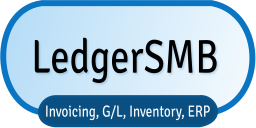Since we never put forth a story describing what features and major changes have made it into 1.3 when feature freeze was declared I figured it would be a good idea to describe these here.
The first thing to keep in mind is that 1.3 is (hopefully) the last major release of LedgerSMB which re-engineers basic security concepts for a while. This means that, while user migration may not be perfectly smooth, the tradeoffs will mean a much more secure system. In 1.2 and prior versions, there was no robust enforcement of permissions. Permissions largely were means of addressing user interface changes rather than denying an individual access to a part of a the program. In 1.3 that changes, finally.
Users in 1.3 are full database users, meaning that one user could access more than one company database and have different permissions on each. The permissions are enforced on the database level, enabling access from other tools without circumventing security enforcement.
Closely related to the enhanced security, we have put in place a system of separation of duties, both for batches and single transactions. This means one person can enter a transaction and it can then be reviewed for accuracy by a second individual. That second individual can delete or post the transaction to the books. This is an important feature because it allows standard accounting controls against theft and human error to be implemented on the software without breaking standard transaction reversal rules. It also allows transactions to be saved while they are works in progress and edited prior to being posted to the books which is something smaller businesses often find helpful as well.
On top of this, there are a number of areas where the changes in the software address workflow issues as well. The first of these that most individuals will see is the fact that customer/vendor management has been completely changed. A single company can be both a customer and vendor, and can have multiple customer/vendor accounts attached for easy tracking. Multiple shipping addresses can be attached to each account as well, and much greater flexibility exists for tracking contact information, bank account information, and the like. Additionally, tax form data can be tracked, such as whether a given account should be subject to 1099-MISC or 1099-INT reporting in the US, or subject to similar reporting abroad. These tax forms can be defined as needed.
A second point that has received a great deal of attention is the payment workflow. As in previous versions, there are two workflow options here: a single payment workflow which is generally helpful in paying a single vendor at a time, and a bulk payment workflow for creating batches of many (perhaps hundreds) of payments at once. The bulk payment workflow has received a great deal of attention in terms of performance and now scales up to thousands of invoices per run. The single payment workflow has enhanced handling of prepayments, etc.
A third point that has received substantial attention is bank account reconciliation. Past versions of the software had a number of specific issues with bank reconciliation including unpleasant surprises in multi-user environments, and an inability to go back and understand what was reconciled when. The new version was designed to allow easy reconciliation of accounts, whether that account has a few transactions per month against it or whether it has a thousand. Furthermore the reconciliation process is subject to separation of duties (see above) and it can be later audited. An individual with access can review past reconciliation efforts in order to determine who reconciled which transactions, who approved the reconciliation, and when it happened. In the reconciliation screen, transactions are grouped by whether or not they are marked as cleared, and can be sorted within each of these groups based on a number of criteria. Additionally there is a plug-in model for building bank import scripts. This allows, with minimal programming, the ability to import files directly from the bank. These are then matched against the transactions in the system, and questionable matches flagged for human review. This allows businesses to minimize the labor involved in reconciling their books.
We trust that these new features and substantial enhancements will make the program far more useful to a wide variety of users. As of this writing, LedgerSMB 1.3.0 is currently undergoing beta testing and could use more testers. Please see our Sourceforge page for more information.
